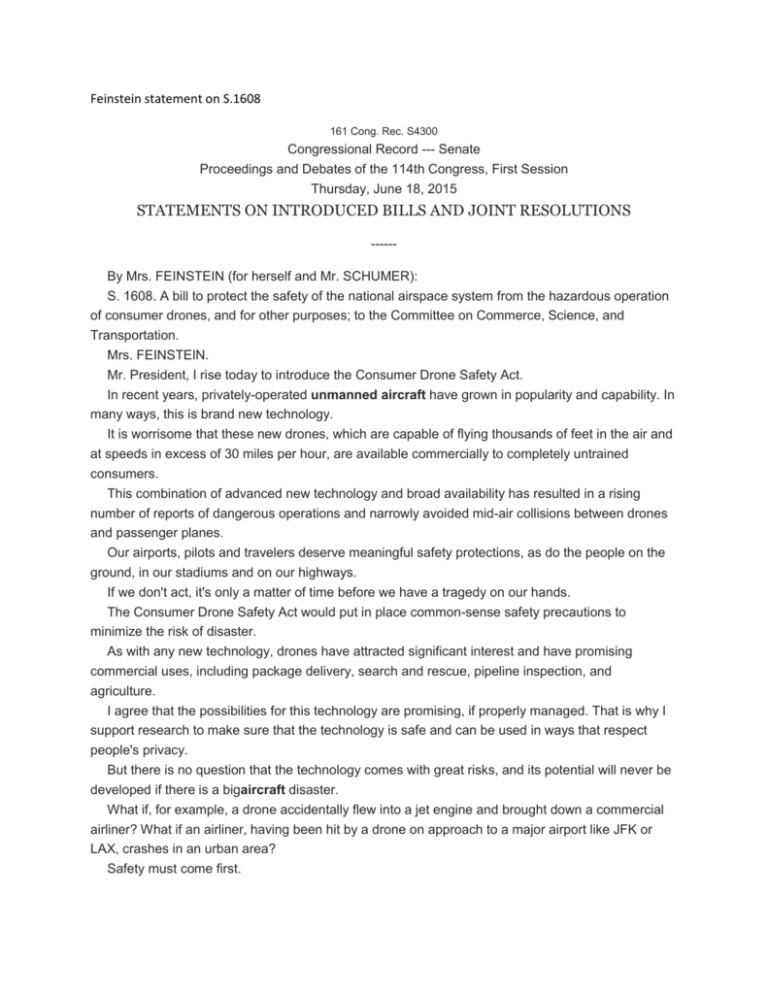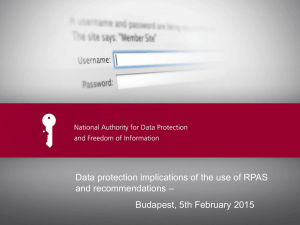Here is Sen. Feinstein`s statement in the Congressional Report
advertisement

Feinstein statement on S.1608 161 Cong. Rec. S4300 Congressional Record --- Senate Proceedings and Debates of the 114th Congress, First Session Thursday, June 18, 2015 STATEMENTS ON INTRODUCED BILLS AND JOINT RESOLUTIONS -----By Mrs. FEINSTEIN (for herself and Mr. SCHUMER): S. 1608. A bill to protect the safety of the national airspace system from the hazardous operation of consumer drones, and for other purposes; to the Committee on Commerce, Science, and Transportation. Mrs. FEINSTEIN. Mr. President, I rise today to introduce the Consumer Drone Safety Act. In recent years, privately-operated unmanned aircraft have grown in popularity and capability. In many ways, this is brand new technology. It is worrisome that these new drones, which are capable of flying thousands of feet in the air and at speeds in excess of 30 miles per hour, are available commercially to completely untrained consumers. This combination of advanced new technology and broad availability has resulted in a rising number of reports of dangerous operations and narrowly avoided mid-air collisions between drones and passenger planes. Our airports, pilots and travelers deserve meaningful safety protections, as do the people on the ground, in our stadiums and on our highways. If we don't act, it's only a matter of time before we have a tragedy on our hands. The Consumer Drone Safety Act would put in place common-sense safety precautions to minimize the risk of disaster. As with any new technology, drones have attracted significant interest and have promising commercial uses, including package delivery, search and rescue, pipeline inspection, and agriculture. I agree that the possibilities for this technology are promising, if properly managed. That is why I support research to make sure that the technology is safe and can be used in ways that respect people's privacy. But there is no question that the technology comes with great risks, and its potential will never be developed if there is a bigaircraft disaster. What if, for example, a drone accidentally flew into a jet engine and brought down a commercial airliner? What if an airliner, having been hit by a drone on approach to a major airport like JFK or LAX, crashes in an urban area? Safety must come first. In the last year, unlawful drone use has proliferated and it's clear that there is a high risk to public safety. In July of 2014, following an expose by Craig Whitlock of the Washington Post, I wrote to the Federal Aviation Administration asking for data about drone flights and accidents. What I received from the FAA was-simply put-startling, and it really crystallized for me the magnitude of the problem we face. In nine months last year, from March through November, there were approximately 25 incidents where a drone nearly collided in midair with a manned aircraft, sometimes requiring evasive action. In this time period, there were more than 190 incident reports. Since July 1, at least one incident per day was reported to the FAA. For example: On May 29, 2014, two aircraft on approach to LAX reported a ”trash can sized” unmanned aircraft at 6,500 feet above ground level. On June 29, 2014, an airplane on descent to Dulles Airport reported a near midair collision with a drone that flew within 50 feet of the plane at 2,800 feet above ground level. On September 8, 2014, three separate airplanes reported ”a very close call” with a drone on descent to LaGuardia airport at 1,900 feet above ground level. On October 12, 2014, an aircraft near Tinker Air Force Base in Oklahoma reported taking evasive action at 4,800 feet above ground level to avoid a drone that came between 10 to 20 feet of the plane. On February 8, 2015, a Southwest passenger jet on its way to land at LAX and reported that a small red drone flew ”right over the top” of the plane at 4,000 feet above ground level. These close calls are absolutely unacceptable. It is not just airplanes and airports that are at risk. For example, the general manager of the Golden Gate Bridge reports that drones routinely fly over traffic on the bridge. One drone recently crashed onto the bridge roadway. Drones equipped with cameras have also flown by the bridge in areas where photography is not permitted for security reasons, which is alarming. The California Department of Forestry and Fire Protection-CAL FIRE-is also growing increasingly concerned about the unsafe use of drones. It reports that during last year's fire season, there were numerous incidents involving drones. For example, in September, one of its helicopters, which was responding to the Pasqualie fire, had to brake in midair to avoid colliding with a recreational drone just 10 feet ahead of it. In May, several drones were filming an active firefight in order to post videos online. If local police hadn't been able to identify the operators and convince them to stop, CAL FIRE believes it might have had to shut down its aerial firefighting operations for the Poinsettia and Cocos fires to avoid the risk of collision. As far back as 2012, the Government Accountability Office, GAO, has issued warnings about obstacles to the safe operation of drones, which include the fact that many drones cannot ”detect, sense and avoid” other aircraft or objects in the airspace. Drones are also plagued by a phenomenon known as ”lost link”-in which the remote connection between the pilot on the ground and the aircraft is simply lost, resulting in a loss of command and control of the aircraft. The GAO's report also noted that many drones ”currently use unprotected radio spectrum and, like any other wireless technology, remain vulnerable to unintentional or intentional interference.” GAO continued: ”This remains a key security and safety vulnerability because, in contrast to a manned aircraft in which the pilot has direct physical control of the aircraft, interruption of radio transmissions can sever the UAS's only means of control.” Even the operators of consumer drones often know that their operations can be dangerous. Let me just read to you from one commenter on Amazon's page for a popular consumer drone: It just kept climbing as it disappeared into the clouds. I lost visual, and was sure I'd never see my Phantom again. . . . From calculations based on DJI's web site that it climbs <6 meters per second, which means it attained an altitude . . . somewhere between 5,000 and 7,000 feet. I didn't realize until I got video back. The commentator continued: ”This is 'not' good, though, since until I saw the video, I didn't realize I was in controlled airspace. Do 'not' do this.” This comment, to me, is really emblematic of what is happening. Consumers with no training, certification, or instruction are buying highly-capable drones with few technological safeguards. There are precautions we can take to reduce the risk of a catastrophic accident. For example, after a consumer drone crashed on the White House lawn in January 2015, the manufacturer voluntarily released a firmware update to prevent flights near Washington, D.C. The update was easy for consumers and commonsense. However, the FAA has no authority to require all manufacturers to follow suit, or to specify other areas that deserve similar protection. Another easy precaution is education of drone operators. For example, the FAA has partnered with the Academy of Model Aeronautics, the Association for Unmanned Vehicle Systems International, and the Small UAV Coalition to develop an educational campaign called ”Know Before You Fly.” This campaign includes sensible advice about staying under 400 feet in elevation, keeping the drone within range of eyesight, flying sober, and staying away from pedestrians, vehicles, and airports. However, the FAA can't require manufacturers to print this type of information and include it in the box for consumers when they buy a new drone. FAA needs the authority to require these basic safety precautions. The Consumer Drone Safety Act calls for sensible new safety regulations in how drones are manufactured and used. These new safety regulations apply only to consumer drones: civil unmanned aircraft that are manufactured for commercial distribution and that are equipped with an automatic stabilization system or are capable of providing a video signal allowing operations beyond the visual line of sight of the operator. Notably, this definition does not override Section 336 of the FAA Modernization and Reform Act of 2012, which means that model aircraft flown for recreational purposes would continue to be subject to the safety guidelines of a community-based organization rather than to operational regulations of the Federal Aviation Administration. The bill has operational requirements The Consumer Drone Safety Act directs the FAA to clearly lay out what is acceptable for consumer drones that are operated outside the programming of a community-based organization, detailing when, where, and under what conditions drones can be operated. This includes how high, how close to airports or stadiums, and under what weather conditions a drone may be flown. The bill has manufacturer requirements. Any drone advanced enough to fly autonomously should also be equipped with advanced safety features, including geo-fencing. But FAA does not currently have authority to require even the most basic safety precautions like providing educational materials. The Consumer Drone Safety Act authorizes FAA to set meaningful safety requirements for manufacturers. These may include geo-fencing to govern the altitude and location of flights, a transponder or other method for pilots and air traffic control to detect and identify the drones, collision-avoidance software, and precautions for the loss of a communications link, anti-tampering safeguards, and educational materials. The bill also requires manufactures to update existing consumer drones to meet these new requirements when feasible. The bill would allow FAA to exempt particular types of consumer drones from any requirement that is technologically infeasible or cost-prohibitive if other precautions enable safe operations. The Consumer Drone Safety Act is straightforward, balanced, and necessary. For the first time, it would allow the FAA to proactively respond to the increasing use and capabilities of consumer drones by requiring sensible precautions to protect the safety of our nation's airports and hospital helipads, stadiums and fairgrounds, bridges, electrical infrastructure, highways, and city sidewalks. Congress must not wait for a tragedy before taking action. I encourage my colleagues to join me in this legislation to ensure that consumer drones are built and operated safely.




